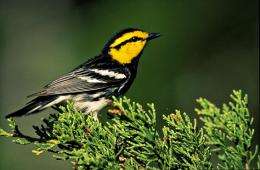New map may help conservation efforts for an endangered songbird

Researchers have developed and used a model to estimate the density of the golden-cheeked warbler, an endangered songbird that breeds in Ashe juniper and oak woodlands in central Texas. In a study published in the Journal of Wildlife Management, the team created a warbler distribution map that identifies areas important for conservation of the species, indicating places where improvement and restoration of habitat may have the greatest benefit.
The model results indicated that management activities to increase warbler density should promote woodlands with high tree canopy cover, approximately 60–80% Ashe juniper composition, and tree heights higher than 3 meters.
"We conducted more than 1,800 point count surveys to determine the distribution of this iconic Texas species that breeds nowhere else in the world," said lead author James M. Mueller, Ph.D., of the U.S. Fish and Wildlife Service. "The species is most abundant in areas with mature juniper-oak woodlands, but our model provides an important new understanding of the conditions where the species occurs in lower densities in associated shrublands such as in the more arid southwestern portion of its range."
More information: Multi-scale species density model for conserving an endangered songbird, Journal of Wildlife Management (2022). DOI: 10.1002/jwmg.22236
Journal information: Journal of Wildlife Management
Provided by Wiley




















